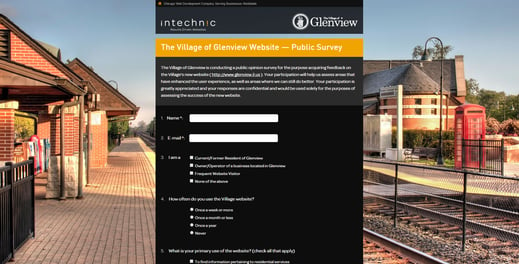 Continued from: 'How to Ensure that Your Website Doesn’t Become Obsolete' The best way to learn how well your new website is received is through user feedback. This is true, especially in the beginning, before there is any data to analyze. Because your customers are the primary users of your website, their opinions not only matter, but these opinions are vital to your website's success. Your customers' collective feedback should be the guiding compass for your long-term website strategy. If you pay attention to this feedback and adjust the website appropriately, you will be more likely to create more customers like those who offered their feedback. If your website works for them, it will work for others too.
Continued from: 'How to Ensure that Your Website Doesn’t Become Obsolete' The best way to learn how well your new website is received is through user feedback. This is true, especially in the beginning, before there is any data to analyze. Because your customers are the primary users of your website, their opinions not only matter, but these opinions are vital to your website's success. Your customers' collective feedback should be the guiding compass for your long-term website strategy. If you pay attention to this feedback and adjust the website appropriately, you will be more likely to create more customers like those who offered their feedback. If your website works for them, it will work for others too.
When requesting or collecting feedback, keep an open mind when reviewing comments. At this point, you are emotionally invested in your website, but it would be a waste of everyone’s time (including yours), if you are going resist modifications or changes to your website. Seek feedback only if you are open to making changes so your website will continually improve.
Benefits of Getting Early Feedback
Following the announcement of your new website release, you will most likely immediately receive feedback from your customers right away. This early feedback is very valuable. People are new to your website, so this initial perspective is of paramount importance. When your customers frequent your website, the feedback content is typically not as rich.
Furthermore, since you and your web developer are currently working on the website, it will be much easier to implement changes at this stage. It will also be more cost-effective and efficient. Finally and most importantly, incorporating feedback early in the game will make a big difference in the long run. Even a little issue that remains unattended regarding the website's ability to convert visitors into customers can result in significant losses over time. By the same token, a simple conversion improvement can result it impressive gains.

As part of a project for a municipality's website redesign project, Intechnic produced a survey for the municipality's residents.
How Useful is Your Feedback?
Feedback is just as valuable as the improvements you can make resulting from the feedback. If a person doesn't like the website without giving you any additional details, their feedback is not very useful to you. When someone says they don't like something on your website, you want to know specifically what they don't like and why they don't like it. This will allow you to make improvements.
When a bug or a usability issue is reported, get all the details from the source. Unless you or your web developer can recreate the issue, it cannot be detected and fixed. When you receive feedback about your website, determine if this feedback is representative of your ideal customer demographic. If not, this feedback is of little or no value, and it could actually be misleading. You can obtain feedback from friends and family, but they could be biased and may not be representative of your customers. Scrutinize the objectivity contained in feedback offered.
How Accurate is Your Feedback?
The statistical accuracy of your feedback is in the numbers. Polling several random individuals will not provide this accuracy. It will simply represent opinions of several individuals. Additionally, if you survey a broad range of individuals whose opinions are “polar opposites” of your customers, the feedback may be misleading or baseless. How do you determine the number of people to survey to generate accurate and valuable feedback? To answer this question scientifically, it depends on several factors, including the size of the population, segmentation, degree of variance in responses and the tolerance for error.
Dr. Van Bennekom of Northeastern University argues in his "Great Book - Organizational Effectiveness through Feedback Management", that as a rule of thumb, 200 responses are required for fairly good accuracy, 100 responses are needed for marginally acceptable accuracy, and 30 responses for acceptable accuracy, (only if you have little variance in responses and you are willing to accept low accuracy). The bottom line is to survey as many as possible to determine a genuine trend. For example, if a single individual doesn't like an element of your website, it shouldn’t raise a significant concern; but if 5 out of 30 surveyed customers concur, there is a reason for concern and immediate attention.
Dealing with the Negative Feedback
It feels great to get praise for the hard work you have invested into the project, but you need to focus on negative comments that contain suggestions for improvement. You certainly don't want excessive criticism, but think of it this way: negative feedback is better than no feedback. Negative feedback is what perpetuates improvement. If you receive negative feedback, you should be grateful that your customers are direct and honest with you in addition to taking the time to offer constructive criticism. This feedback is what allows you to turn your website's weaknesses into strengths.
Do not be discouraged by negative feedback. While some feedback can be a learning opportunity, other feedback may be worthless. No matter how great your website you will always get feedback from individuals who “don’t get it” or “don’t like it.” This doesn’t mean you should necessarily act on this feedback. Some people are impossible to please, and given the opportunity, they will find something wrong with your website. You have to learn to filter out such feedback. Before jumping to redoing or changing your website, determine if the feedback you've received is 1) useful and 2) statistically accurate (see previous sections).
Next: Best Tools to Collect Customer Feedback for your Website




